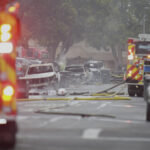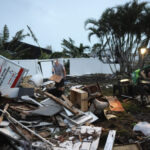Favorable weather conditions help put a damper on the wildfire seasons in Wyoming and Montana this past summer.
Fire officials in both states report that while the number of fire starts was about normal, the fires were generally smaller than in recent years and quickly put out.
“We had quite a bit of activity as far as initial attack goes, but for the most part everything was kept small,” Wyoming State Forester Bill Crapser said.
“With the exception of one fire late in the season northeast of Billings, we had a substantially less than normal year,” Montana State Forester Bob Harrington said.
Crapser said Wyoming has averaged about 750 fires a year over the last 18 years.
“It looks like this year we’re going to be down around 500 fires,” he said.
Not counting fires on federal land, the state normally records about 100,000 burned acres a year, or about 156 square miles, Crapser said.
“And we’re going to be way down in about the 20,000, if that, level this year for nonfederal fires,” he said, noting that some counties don’t report their fire statistics until the winter.
The three biggest fires in Wyoming were all on federal land, burning about 93,000 acres. In all three fires, fire managers let parts of them burn unhindered because it benefited forest health.
Harrington said there were about 1,600 fires that burned 283,000 acres, or about 442 square miles, in Montana.
The 10-year average for Montana is about 1,800 fires and 411,000 acres burned, he said.
“I think that the big story was just having a what we used to call a more typical spring where we had rain, fairly cold temperatures well into June, and so it really compressed the amount of time where you had extreme fire danger,” Harrington said.
In addition, Crapser and Harrington said, there was notably less dry lightning, or summer thunderstorms where no rain falls.
“Most of the lightning we had, it rained real hard with it,” Crapser said. “Most summers we get a lot of dry lightning.”
And the fires that did start were limited because there was adequate moisture to keep vegetation from drying out too much, he said.
Still, there were challenging wildfires such as the one that threatened Red Lodge, Mont.
“Even in the middle of these statistics with numbers less than normal and all that, we did have some pretty problematic fires that we dodged the bullet on,” Harrington said.
Crapser and Harrington say this year’s fire season has no bearing on what might happen next year.
“In just the six years I’ve been in this job, we’ve had seasons where we’ve had record snowfall and wet springs and then record temperatures in June and July, and we’ve had pretty really extreme fire seasons,” Harrington said. “We’ve also had seasons that going into it we had low snowpack, low spring rains, everything was lined up pretty extreme here and then we didn’t get the ignition. So it’s really difficult to predict with any sort of accuracy, especially this far out.”
Added Crapser, “It all depends on what Mother Nature does to us.”
Was this article valuable?
Here are more articles you may enjoy.

 UBS Client Can’t Sue Bank Over Broker’s Alleged Affair With Wife
UBS Client Can’t Sue Bank Over Broker’s Alleged Affair With Wife  Plane Crashes into San Diego Neighborhood, Setting Homes And Vehicles on Fire
Plane Crashes into San Diego Neighborhood, Setting Homes And Vehicles on Fire  We Have Entered A New Era of Auto Claims Complexity
We Have Entered A New Era of Auto Claims Complexity  Here Comes Another Busy Atlantic Hurricane Season, But Will It Be as Crazy as 2024?
Here Comes Another Busy Atlantic Hurricane Season, But Will It Be as Crazy as 2024? 